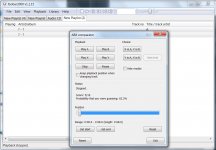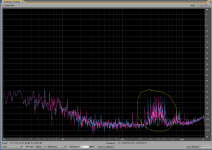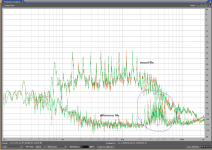Yes, thanks, I fully understand that it's sorting test, and that I should not give away any of my answers at this time, all good.Dan, it's not an ABX test, it's a sorting test.
Discuss what you perceive as sonic differences between A and B all you like, but try not to give away your answers and sabotage Mooly's efforts to do things in a better controlled manner than most of the other "tests" I've seen posted here.
My point is that this is an opportunity if Mooly wants it to be, to discuss perceived differences for the benefit of all in order that all participants are to their individual satisfaction able to characterise the two recordings.
Participants could then announce their subjective findings of the two files, or even proclaim which is which for CapA/CapB....or which is which for OpampA/OpampB.
And then comes the acid test of the Foobar ABX test.
This would be a different way of doing an ABX test.
Dan.
Pavel: Then sorting the files should be easy. I look forward to seeing your results.
Dan: This isn't an ABX test, it is not structured as one. Any ABX results you get may be interesting to you, but do not address what the test is asking. Sort the files, give Mooly your answer sheet. Feel free to discuss the differences you hear between the reference files.
Dan: This isn't an ABX test, it is not structured as one. Any ABX results you get may be interesting to you, but do not address what the test is asking. Sort the files, give Mooly your answer sheet. Feel free to discuss the differences you hear between the reference files.
Idiot Checking....
Dan.
Ok, this is good error testing. Thank you.We have 14 different files - it can be proven. How shall we sort them, SY, would you give us a key? They are dissimilar enough to be considered unique.
Dan.
Last edited:
File alignments differ by 3-68 samples.
Not enough spectral energy below 70Hz to get good approximation of linear transfer function.
Noise modulation for D/A A/D and 16bit depth effectively masks potential differences.
Pavel,
Ditto on Foobar ABX. I've done digital loopback IR recovery both by MLS and swept sine. Performance is good to LSB, with extensive identity throughout.
Frank has phobia to ABX, I think it challenges his pride in his admittedly great discrimination.
Resistor net with electrolytic caps may effectively damp any HD they may produce.
I got very good match for B and Test01, but may have been file naming error during hasty yet lengthy processing session.
Only sine/swept sine down to single Hz region will yield results with highly significant correlation.
This test equates to testing wire between two caps. Nothing to fuss about.
Not enough spectral energy below 70Hz to get good approximation of linear transfer function.
Noise modulation for D/A A/D and 16bit depth effectively masks potential differences.
Pavel,
Ditto on Foobar ABX. I've done digital loopback IR recovery both by MLS and swept sine. Performance is good to LSB, with extensive identity throughout.
Frank has phobia to ABX, I think it challenges his pride in his admittedly great discrimination.
Resistor net with electrolytic caps may effectively damp any HD they may produce.
I got very good match for B and Test01, but may have been file naming error during hasty yet lengthy processing session.
Only sine/swept sine down to single Hz region will yield results with highly significant correlation.
This test equates to testing wire between two caps. Nothing to fuss about.
We have 14 different files - it can be proven. How shall we sort them, SY, would you give us a key? They are dissimilar enough to be considered unique.
If the sound of electrolytic coupling caps is easily audible, you should have an easy time sorting them.
Yes, when you make the files one by one, sorting via file analysis is difficult. But this isn't a test of file analysis, it's a test of audibility.
I don't have a key, and really, why would you want to peek? If you trust your ears, use them. If you get a null result, that's useful information.
This test equates to testing wire between two caps. Nothing to fuss about.
The difference is mostly in a very sensitive part of audio band. Do you have any idea what it could be?
Attachments
A or B files are not same to any of the further 12 files. There are ALWAYS differences. The difference can be seen both in frequency domain and sample values. Attached is the difference in 1st 3 second between A and B in frequency domain. In time domain, "B" is a bit compressed compared to "A".
I can only say that the files sound same if they are same. I assume I have proven the difference by my ABX result. How can we 'pair' A or B to other files if any of them is different???
Pavel, you must try to "pair" A or B with the other files just by listening. I know you felt you could differentiate these by listening and thought clear differences were heard. What we are looking for is the particular and unique "sound" that characterizes one or other reference file to be picked out reliably in the random selection. That is a unique opportunity and shows beyond doubt that the listener really can pick up on the differences.
We have 14 different files - it can be proven. How shall we sort them, SY, would you give us a key? They are dissimilar enough to be considered unique.
No one other than myself knows the key to these and that data is safe and backed up in case of disaster.
The difference is mostly in a very sensitive part of audio band. Do you have any idea what it could be?
When it comes to analysing files you guys are way ahead of me, but that puts me at a kind of advantage because I question what I see...
So a question. If you had two of the random files that were of the same chain (film or electro) would you still find these kind of differences in exactly the same places between those the two files ?
Is it possible that the differences you see at times are artifacts of the analysis ?
Is it possible that a track played on a CD player can show minute differences each time its played ? At the very low levels you sometimes look at, could something like that be occurring. Noise is random. Could something be affecting the sampling processes either in the playback chain, the recording chain or the analysing chain.
I haven't answers to those kind of questions... but even if something like that is occurring the overall "trait" of a particular component if it has one should come through over many random tests.
Yes, my setup is 'primitive' compared to what others would have: the DAC would be a nothing unit, standard motherboard issue, but the PC is a decent, commercial quality Compaq item, which may or may not help. Fed out to very decent, but just small plastic, Harman monitors - no subwoofer.I recall that Fas42 / Frank is using his on board sound card or a slot sound card, so it's more feasible that this could be happening with his setup.
I'm assuming that most of us use outboard DACs, either SPDIF (gasp) or USB.
Frank, maybe you could detail your computer setup as compared to say PMA / Pavel. Not to bash but to compare.
Cheers,
Jeff
Overall setup responds strongly to warm-up conditioning, from cold start very ordinary, mid-fi sound; for serious listening needs a heavy workout for at least an hour or two.
The interesting thing, to pick up what's been mentioned, is that it's actually easier to discriminate files when running 'rough' - the edginess, lack of refinement emphasises the slight differences between samples, rather than 'hiding' them ...
Foobar is something else again, on my machine it always dulls or subtracts some of the 'sparkle' or life from the sound - 2 samples, one slightly livelier than the other, in Nero, say - become almost equal in dullness in Foobar ...
Tried with headphones, computer DAC and background noise:


PS Here's the Foobar ABX stuff if you want to try:
foobar2000: Components Repository - ABX Comparator
Double click to install, then highlight two clips and right click and utilities and 'abx'
You can play the two files (A and B) and then X and Y (randomized A or B) and then say A is X or A is Y. Wash and Repeat until you move from lucky/unlucky guessing to statistically significant preferences (~10-15 tries).
It can restart from the 'beginning' (good to target specific sounds) or switch between perfectly synchronized tracks (good for overall, "wholeistic' ).

PS Here's the Foobar ABX stuff if you want to try:
foobar2000: Components Repository - ABX Comparator
Double click to install, then highlight two clips and right click and utilities and 'abx'
You can play the two files (A and B) and then X and Y (randomized A or B) and then say A is X or A is Y. Wash and Repeat until you move from lucky/unlucky guessing to statistically significant preferences (~10-15 tries).
It can restart from the 'beginning' (good to target specific sounds) or switch between perfectly synchronized tracks (good for overall, "wholeistic' ).
This is something I believe strongly in ... every time the audio signal goes through a complete chain, to finally excite the air molecules, or be 'locked' into a digital data stream it will be different, there is never the same 'thing', ever ...Is it possible that a track played on a CD player can show minute differences each time its played ? At the very low levels you sometimes look at, could something like that be occurring. Noise is random. Could something be affecting the sampling processes either in the playback chain, the recording chain or the analysing chain.
Why? Because the physical universe is a highly complex mechanism, constantly transitioning from one state of 'stability' to the next, due to a myriad of factors, subtle elements everywhere in the environment are impacting ...
Tried with headphones, computer DAC and background noise:
Interesting result
I have also posted one
http://www.diyaudio.com/forums/ever...ening-test-part-1-passives-2.html#post3798748
but was told they do not want ABX but sorting
you cannot step into the same river twice
Karl, I wrote this for the reason you are asking. But, I do not suspect CD player that much (it always plays same data), but rather the sound card used (sampling is not simultaneous for different recordings, the samples occur in different time points, we have some jitter, etc. etc.). That's also the reason why I asked for 24 bit recordings. We also/always should have a set of distortion measurements of the devices used (both D/A and A/D) to predict if they are sufficient for the task we would like to investigate.
Karl, I wrote this for the reason you are asking. But, I do not suspect CD player that much (it always plays same data), but rather the sound card used (sampling is not simultaneous for different recordings, the samples occur in different time points, we have some jitter, etc. etc.). That's also the reason why I asked for 24 bit recordings. We also/always should have a set of distortion measurements of the devices used (both D/A and A/D) to predict if they are sufficient for the task we would like to investigate.
Last edited:
you cannot step into the same river twice
OK, so two things can't ever be compared. Yet you posted several two file tests.
Creative, I'll grant you that. Dragon in the garage.
If all the files could be determined to be identical to iether A or B via software analysis then we would not have a blind test!!
What is being tested here is the ability to pick up on a sonic signature imparted by particular components. If this sonic signature is large (and detectable) then regardless of other very minor differences (perhaps due to jitter or low level noise etc) then it should be possible to sort the files regardless of other minor differences.
So whilst there may be some other differences between files, what is being tested is the ability to pick up a particular sonic difference which should be consistent.
It is of course possible that differentiation between A and B (and successful ABX testing) could be due to differences other than the one being tested, in which case the sorting may fail (as it is not the thing being tested that is what is being heard as a difference).
One would hope however that the sonic signature being tested for would swamp any random differences in playback/recording.
Tony.
What is being tested here is the ability to pick up on a sonic signature imparted by particular components. If this sonic signature is large (and detectable) then regardless of other very minor differences (perhaps due to jitter or low level noise etc) then it should be possible to sort the files regardless of other minor differences.
So whilst there may be some other differences between files, what is being tested is the ability to pick up a particular sonic difference which should be consistent.
It is of course possible that differentiation between A and B (and successful ABX testing) could be due to differences other than the one being tested, in which case the sorting may fail (as it is not the thing being tested that is what is being heard as a difference).
One would hope however that the sonic signature being tested for would swamp any random differences in playback/recording.
Tony.
It is of course possible that differentiation between A and B (and successful ABX testing) could be due to differences other than the one being tested, in which case the sorting may fail (as it is not the thing being tested that is what is being heard as a difference).
Good observation/analysis, Tony. Did you know that this is a strawman test?
What is being tested here is the ability to pick up on a sonic signature imparted by particular components. If this sonic signature is large (and detectable) then regardless of other very minor differences (perhaps due to jitter or low level noise etc) then it should be possible to sort the files regardless of other minor differences.
I am sorry, but I cannot agree. What would you define as 'minor differences' ? In case that errors of the method were higher or comparable to differences investigated, the test would be invalid. This applies to any scientific investigation. The differences between files here are not 'minor', if we check what is happening between 2kHz and 10kHz.
I appreciate an effort to make a valid test, but technical part of the test has the same importance as the methodology used.
Attachments
If others want a push along,, I just sent off a first sorting of samples to Mooly, but only did half - the downloading gets to be a drag ...

And very much appreciated it is too... many thanks
(And we need more to do as Frank has done. I keep saying this over and over... we have a unique opportunity here to do a statistically valid test. Lets use it
This is something I believe strongly in ... every time the audio signal goes through a complete chain, to finally excite the air molecules, or be 'locked' into a digital data stream it will be different, there is never the same 'thing', ever ...
Why? Because the physical universe is a highly complex mechanism, constantly transitioning from one state of 'stability' to the next, due to a myriad of factors, subtle elements everywhere in the environment are impacting ...
I'm certainly open to the "different every time" theory... Pavels thoughts on sampling in the sound card make sense... but I think that applies to the sampling for the analysis too.
- Status
- This old topic is closed. If you want to reopen this topic, contact a moderator using the "Report Post" button.
- Home
- General Interest
- Everything Else
- Listening Test Part 1. Passives.

